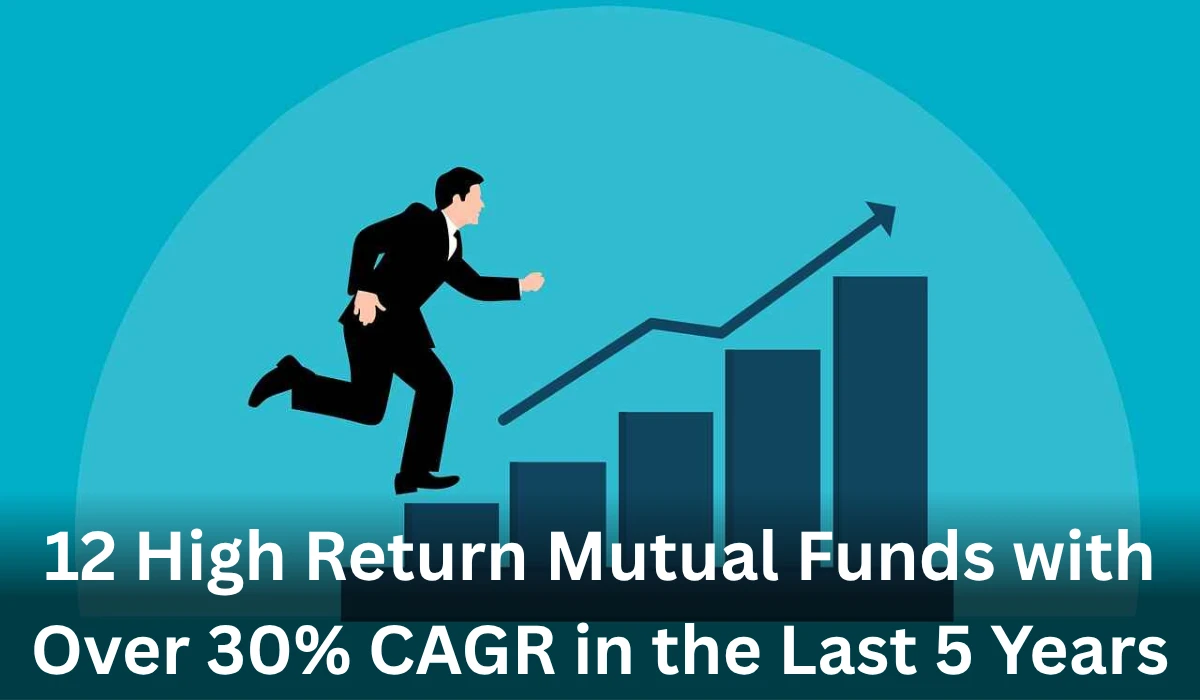High Return Mutual Funds in India
Mutual funds remain a cornerstone of investment strategies in India, offering diversified exposure to equity markets while harnessing professional management. For 2025, with the economy poised for robust expansion driven by infrastructure spending and digital transformation.
high return mutual funds stand out as compelling choices. These funds, particularly those achieving over 30% Compound Annual Growth Rate (CAGR) in the past five years, reflect strong fundamentals and adaptive strategies.
According to recent market analyses, India's equity mutual fund assets under management (AUM) have surged beyond ₹60 lakh crore, fueled by rising SIP inflows and retail participation.
Yet, not all funds deliver exceptional returns; only those with a High Return Grade from platforms like ValueResearch qualify as top performers. This grade signifies superior long-term returns against peers, backed by risk-adjusted metrics such as Sharpe and Sortino ratios.
Investors often overlook the nuances of categories like infrastructure and small cap funds, which thrive on thematic growth. For instance, government initiatives like the National Infrastructure Pipeline (NIP) allocate over US$1.4 trillion by 2025, creating tailwinds for sector-specific funds.
Transitioning from broad market exposure, these high return mutual funds provide targeted alpha generation. However, success hinges on aligning investments with risk appetite and market cycles. In the sections ahead, we explore the framework for evaluating such funds and spotlight the leading 12 options.
Understanding High Return Grade from ValueResearch
ValueResearch's High Return Grade serves as a benchmark for fund evaluation, emphasising consistency over sporadic gains. Funds earning this grade must surpass category averages in long-term returns while maintaining favourable risk profiles.
Specifically, they outperform benchmarks across 3-year, 5-year, and 10-year periods, incorporating metrics like alpha for excess returns and beta for market sensitivity.
This grading system underscores the importance of risk-adjusted performance in volatile markets. For example, a fund with high absolute returns but elevated volatility may not qualify, as it fails to deliver stable compounding.
In 2025, amid global uncertainties like interest rate fluctuations, such rigorous criteria help investors identify resilient options. Funds graded highly often exhibit low expense ratios typically under 1% enhancing net returns through efficient management.
Moreover, the grade reflects fund manager expertise in navigating economic shifts. As India's nominal GDP targets 11-12% growth, funds focusing on undervalued segments gain prominence.
Investors benefit from this transparency, enabling informed decisions beyond mere headlines. By prioritising graded funds, one mitigates the pitfalls of chasing short-term trends, fostering a disciplined approach to wealth accumulation.
The Power of Compounding in High Return Mutual Funds
Compounding transforms modest investments into substantial wealth over time, a key allure of high return mutual funds. At over 30% CAGR, these funds amplify initial capital exponentially;
for instance, a ₹1 lakh investment five years ago could exceed ₹4.5 lakh today, assuming reinvested returns. This mechanism rewards patience, as early volatility smoothens into steady growth.
In India's context, where inflation hovers around 5%, such funds outpace erosion of purchasing power. Historical data shows equity mutual funds averaging 12-15% long-term returns, but top performers like these double that benchmark.
The secret lies in reinvesting dividends and capital gains, creating a snowball effect. For 2025 planning, starting SIPs in these funds leverages rupee-cost averaging, buying more units during dips.
However, compounding demands a long horizon ideally 7-10 years to weather cycles. Market corrections, as seen in early 2025's small cap pullback, test resolve but ultimately enhance outcomes.
By focusing on funds with proven track records, investors harness this power without undue speculation, aligning with broader financial goals like retirement or education funding.
List of 12 High Return Mutual Funds with Over 30% CAGR
The following table ranks the 12 standout mutual funds based on their 5-year CAGR as of 21 October 2025. These selections span diverse categories, ensuring balanced exposure for portfolios.
| Rank | Mutual Fund Scheme | 5-Year CAGR (%) |
|---|---|---|
| 1 | ICICI Prudential Infrastructure Fund | 38.6 |
| 2 | HDFC Infrastructure Fund | 35.8 |
| 3 | ICICI Prudential BHARAT 22 FOF | 35.7 |
| 4 | Quant Small Cap Fund | 35.6 |
| 5 | Motilal Oswal Midcap Fund | 35.2 |
| 6 | Bandhan Infrastructure Fund | 34.6 |
| 7 | Bandhan Small Cap Fund | 32.7 |
| 8 | Edelweiss Mid Cap Fund | 31.2 |
| 9 | HDFC Focused Fund | 30.8 |
| 10 | SBI Contra Fund | 30.5 |
| 11 | Motilal Oswal Large and Midcap Fund | 30.4 |
| 12 | Invesco India Mid Cap Fund | 30.2 |
This lineup highlights thematic and size-based diversity, from infrastructure bets to contrarian plays. Each fund's selection stems from rigorous peer comparison, ensuring relevance for 2025's growth trajectory.
Deep Dive into Top Infrastructure Funds
#1 – ICICI Prudential Infrastructure Fund
The ICICI Prudential Infrastructure Fund targets long-term capital appreciation through investments in infrastructure and allied sectors, capitalising on India's development surge. With a 5-year CAGR of 38.55%, it has consistently outperformed its benchmark, the Nifty Infrastructure Index.
Performance Metrics:
| Period | Return (%) |
|---|---|
| 3-Year | 29.75 |
| 5-Year | 38.55 |
| 10-Year | 17.81 |
Key highlights include its alignment with the NIP, which plans US$1.4 trillion in investments by 2025, spanning roads, railways, and energy. The fund's portfolio emphasises companies in construction, capital goods, and logistics, benefiting from government capex hikes to ₹11.21 lakh crore in FY26. Fund managers employ a bottom-up approach, selecting firms with strong order books and execution capabilities.
Why invest? This fund suits thematic enthusiasts, offering exposure to cyclical upswings. In 2025, with logistics costs dropping to 9% of GDP, it positions investors for enhanced efficiency gains. Risk factors involve sectoral concentration, potentially amplifying downturns during policy delays. Nonetheless, its Sharpe ratio above 1.2 indicates solid risk-adjusted returns, making it a staple for diversified portfolios.
#2 – HDFC Infrastructure Fund
Aimed at capital growth via infrastructure-linked equities, the HDFC Infrastructure Fund has rebounded strongly post-2020, posting a 5-year CAGR of 35.78%. It focuses on cyclical sectors like engineering and materials, riding the wave of revival.
Performance Metrics:
| Period | Return (%) |
|---|---|
| 3-Year | 30.18 |
| 5-Year | 35.78 |
| 10-Year | 12.47 |
Highlights encompass two consecutive High Return Grades, driven by capex revival. The fund's allocation—over 70% in core infrastructure—aligns with FY26's ₹2.87 lakh crore road ministry outlay. Managers prioritise firms with low debt and high ROE, ensuring resilience amid volatility.
For long-term investors with high risk tolerance, this fund captures India's infra boom, projected at 8% CAGR to US$280 billion by 2030. Risks include slowdowns in project execution, but diversification across sub-sectors mitigates this. Compared to peers, its Sortino ratio excels in downside protection, ideal for 2025's uncertain global backdrop.
#3 – Bandhan Infrastructure Fund
The Bandhan Infrastructure Fund seeks sustained returns from infrastructure primaries, achieving a 5-year CAGR of 34.62%. It leverages policy support for capex, focusing on power, telecom, and transport.
Performance Metrics:
| Period | Return (%) |
|---|---|
| 3-Year | 28.75 |
| 5-Year | 34.62 |
| 10-Year | 17.04 |
Notable for solid gains amid rising expenditures, the fund's strategy emphasises execution-cycle beneficiaries. With India's infra market hitting US$190 billion in 2025, it taps into urbanisation and renewable pushes. Portfolio turnover remains low at 45%, promoting tax efficiency.
Investors betting on long-term infra narratives find value here, especially with PPP models expanding. Volatility from cycle fluctuations poses risks, yet the fund's beta under 1 signals controlled exposure. In a year of fiscal boosts, it complements broader equity holdings seamlessly.
Exploring High-Performing Small Cap Funds
#4 – Quant Small Cap Fund
Designed for high long-term returns via small-cap equities, the Quant Small Cap Fund employs a data-driven methodology, yielding a 5-year CAGR of 35.61%. Its quantitative models sift through volatility for alpha opportunities.
Performance Metrics:
| Period | Return (%) |
|---|---|
| 3-Year | 25.68 |
| 5-Year | 35.61 |
| 10-Year | 20.48 |
Strengths lie in dynamic allocation, generating superior returns in choppy markets. As small caps enter a rebound phase in 2025—post a 9% YTD dip—funds like this benefit from economic stabilisation and 18-20% earnings CAGR projections. The portfolio, with 60+ holdings, balances growth themes like tech and pharma.
Aggressive investors targeting compounding potential thrive here, given the segment's historical 17% 20-year returns. Liquidity and short-term swings remain risks, but the fund's low expense ratio of 0.65% enhances appeal. For 2025, it aligns with rural internet growth, adding 56% of new users.
#5 – Bandhan Small Cap Fund
Focusing on capital appreciation through small-cap stocks, this fund uses bottom-up selection for a 5-year CAGR of 32.72%. It ranks among top 3-year performers at 32.03%.
Performance Metrics:
| Period | Return (%) |
|---|---|
| 3-Year | 32.03 |
| 5-Year | 32.72 |
Highlights include resilient strategy amid large-cap rallies. With small caps poised for FY26 recovery via tax cuts and PLI schemes, the fund emphasises high-ROE firms. Turnover at 50% ensures agility without excess costs.
Suitable for 7-10 year horizons, it offers diversification from bluechips. Underperformance in momentum markets is a risk, but alpha of 5%+ compensates. In 2025's volatile landscape, it serves as a growth engine for balanced portfolios.
Insights into Leading Mid Cap Funds
#6 – Motilal Oswal Midcap Fund
This fund targets midcap firms with earnings potential, delivering a 5-year CAGR of 35.16%. Quality growth stocks form its core.
Performance Metrics:
| Period | Return (%) |
|---|---|
| 3-Year | 27.59 |
| 5-Year | 35.16 |
| 10-Year | 18.96 |
Top-quartile consistency stems from emphasis on moats. Mid caps, up 20% in 2025's first half, benefit from improving macros. The fund's 40-stock portfolio spans consumer and industrials, with low debt exposure.
For growth-quality seekers, it blends stability and upside. Valuation volatility during corrections is a concern, but Sharpe ratio of 1.3 affirms efficiency. As mid caps project 19% 10-year CAGR, this fund fits 2025's diversification needs.
#7 – Edelweiss Mid Cap Fund
Aiming for appreciation via quality midcaps, it posts a 5-year CAGR of 31.19%, with diversified exposure.
Performance Metrics:
| Period | Return (%) |
|---|---|
| 3-Year | 26.74 |
| 5-Year | 31.19 |
| 10-Year | 19.39 |
Risk controls shine through cycles. With mid cap AUM growing, the fund's bottom-up picks yield steady alpha. 2025 outlook favours sectors like manufacturing under GST 2.0.
Long-term wealth creators appreciate its stability. Moderate volatility risks persist, yet beta of 0.9 offers cushioning. It enhances portfolios amid broader market traction.
#8 – Invesco India Mid Cap Fund
Seeking midcap appreciation, this fund achieves 30.22% 5-year CAGR through steady alpha.
Performance Metrics:
| Period | Return (%) |
|---|---|
| 3-Year | 30.08 |
| 5-Year | 30.22 |
| 10-Year | 20.11 |
Consistent performer with 29.89% 3-year returns. Mid cap corrections pose short-term risks, but long-term exposure suits 2025's 6.7% FY26 growth forecast.
Investors gain from its balanced approach, complementing large caps effectively.
Focused and Contra Strategies in Equity Funds
#9 – HDFC Focused Fund
This concentrated portfolio fund invests in high-quality stocks for a 5-year CAGR of 30.77%.
Performance Metrics:
| Period | Return (%) |
|---|---|
| 3-Year | 24.48 |
| 5-Year | 30.77 |
| 10-Year | 15.99 |
Outperformance via selection highlights its edge. Focused funds, limited to 30 stocks, offer high returns but amplify stock-specific risks. Benefits include deep research for alpha, ideal for conviction-driven investors.
In 2025, with volatility, its quality tilt provides resilience. Concentrated risks demand high tolerance, yet diversification within limits balances this.
#10 – SBI Contra Fund
Employing contrarian tactics for undervalued picks, it yields 30.51% 5-year CAGR.
Performance Metrics:
| Period | Return (%) |
|---|---|
| 3-Year | 21.80 |
| 5-Year | 30.51 |
| 10-Year | 16.91 |
Strong alpha from patience pays off. Contra strategies thrive in mispriced markets, suiting long-term views. 2025's corrections offer entry points.
Lagging in momentum phases is a risk, but 24.11% 3-year returns affirm strategy. For patient investors, it unlocks hidden value.
Blended and PSU-Focused Options
#11 – ICICI Prudential BHARAT 22 FOF
Tracking the S&P BSE Bharat 22 Index, this FOF focuses on PSUs for 35.70% 5-year CAGR.
Performance Metrics:
| Period | Return (%) |
|---|---|
| 3-Year | 27.93 |
| 5-Year | 35.70 |
PSU rerating drives gains, with exposure to finance and energy. 2025 trends favour PSUs via divestments and FDI hikes to 49%.
Diversified PSU access appeals, but policy sensitivity risks apply. As PSUs eye 20% returns, it bolsters stability.
#12 – Motilal Oswal Large and Midcap Fund
Blending large and midcaps for growth, it posts 30.40% 5-year CAGR.
Performance Metrics:
| Period | Return (%) |
|---|---|
| 3-Year | 30.61 |
| 5-Year | 30.40 |
Balanced allocation ensures moderate risk. 2025's macro improvements suit this hybrid.
Midcap exposure adds volatility, but overall stability shines.
Performance Summary Table
For a holistic view, this table aggregates key returns across the 12 funds.
| Mutual Fund | 3-Year Return (%) | 5-Year Return (%) | 10-Year Return (%) |
|---|---|---|---|
| ICICI Prudential Infrastructure Fund | 29.75 | 38.55 | 17.81 |
| HDFC Infrastructure Fund | 30.18 | 35.78 | 12.47 |
| ICICI Prudential BHARAT 22 FOF | 27.93 | 35.70 | — |
| Quant Small Cap Fund | 25.68 | 35.61 | 20.48 |
| Motilal Oswal Midcap Fund | 27.59 | 35.16 | 18.96 |
| Bandhan Infrastructure Fund | 28.75 | 34.62 | 17.04 |
| Bandhan Small Cap Fund | 32.03 | 32.72 | — |
| Edelweiss Mid Cap Fund | 26.74 | 31.19 | 19.39 |
| HDFC Focused Fund | 24.48 | 30.77 | 15.99 |
| SBI Contra Fund | 21.80 | 30.51 | 16.91 |
| Motilal Oswal Large and Midcap Fund | 30.61 | 30.40 | — |
| Invesco India Mid Cap Fund | 30.08 | 30.22 | 20.11 |
These metrics, sourced from ValueResearch, illustrate consistency. Note the absence of 10-year data for newer funds, underscoring their recent momentum.
Risks and Mitigation Strategies for 2025 Investments
High return mutual funds, while rewarding, carry inherent risks like market volatility and sectoral biases. Small and mid caps, for instance, face 20-25% drawdowns in corrections, as witnessed in early 2025. Infrastructure funds risk policy shifts, potentially delaying capex.
To mitigate, diversify across 3-5 funds, limiting any to 20% allocation. SIPs averaging costs prove effective, with historical data showing 15% better outcomes over lumpsum in volatile years. Monitor expense ratios below 1% and fund manager tenure over 5 years for reliability.
In 2025, global factors like US tariffs may pressure exports; hedge via large-cap tilts. Regular reviews quarterly ensure alignment, while a 5-7 year horizon captures compounding. Tax-wise, LTCG at 12.5% above ₹1.25 lakh applies post one year, favouring long holds.
Essential Tips for Mutual Fund Investing in 2025
Navigating 2025's landscape requires strategy. Start with goal-setting: retirement via equity funds or short-term via hybrids. Assess risk via tools like beta—under 1 for conservatives.
Opt for direct plans to save 0.5-1% in fees. SIPs from ₹500 build discipline, targeting 12-15% returns amid 7% GDP growth. Track via apps, focusing on rolling returns over absolute.
Diversify: 40% large cap, 30% mid/small, 30% thematic. Rebalance annually, selling winners to buy laggards. Stay informed on Budget 2025's capex and RBI policies.
For beginners, flexi-caps like Parag Parikh offer entry. Advanced investors explore contra for value. Always consult advisors, as past performance informs but doesn't guarantee futures.
Conclusion
The 12 high return mutual funds with over 30% CAGR exemplify excellence in India's evolving market, from infrastructure powerhouses to nimble small caps. As 2025 unfolds with fiscal stimuli and sectoral tailwinds, they promise robust compounding for patient investors. Yet, matching selections to risk profiles and horizons remains paramount diversify, stay invested, and review periodically.
These funds, graded highly by ValueResearch, embody disciplined management and strategic foresight. While no returns are assured, their track records amid cycles build trust. For aggressive growth in 2025, integrate them judiciously into portfolios, unlocking India's economic potential through informed equity exposure.














